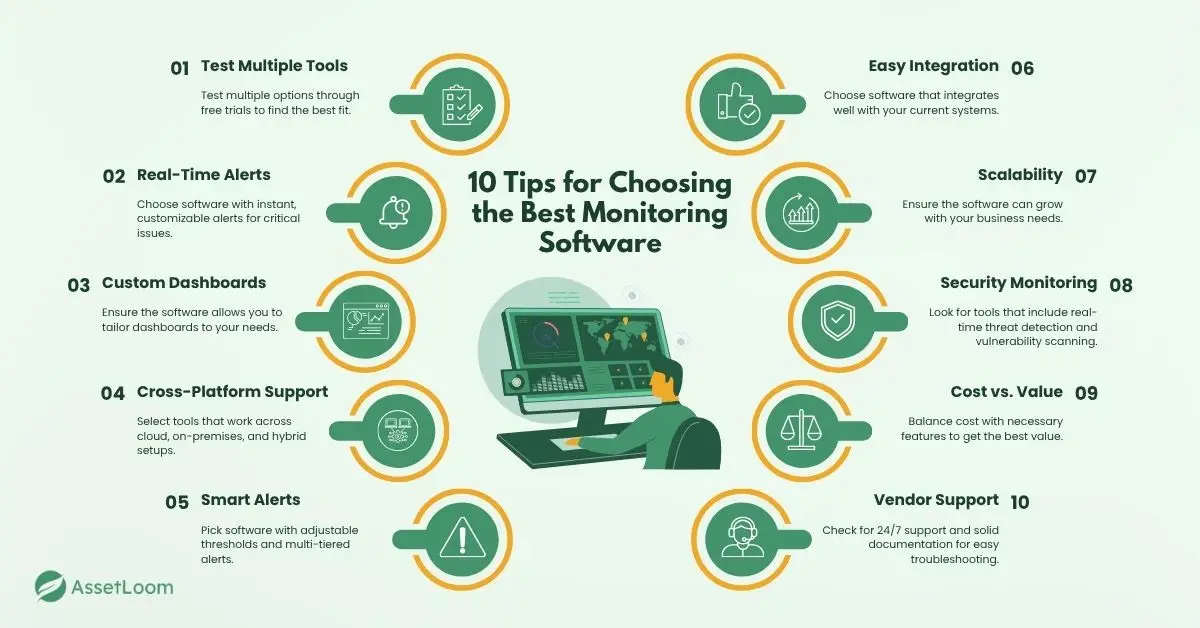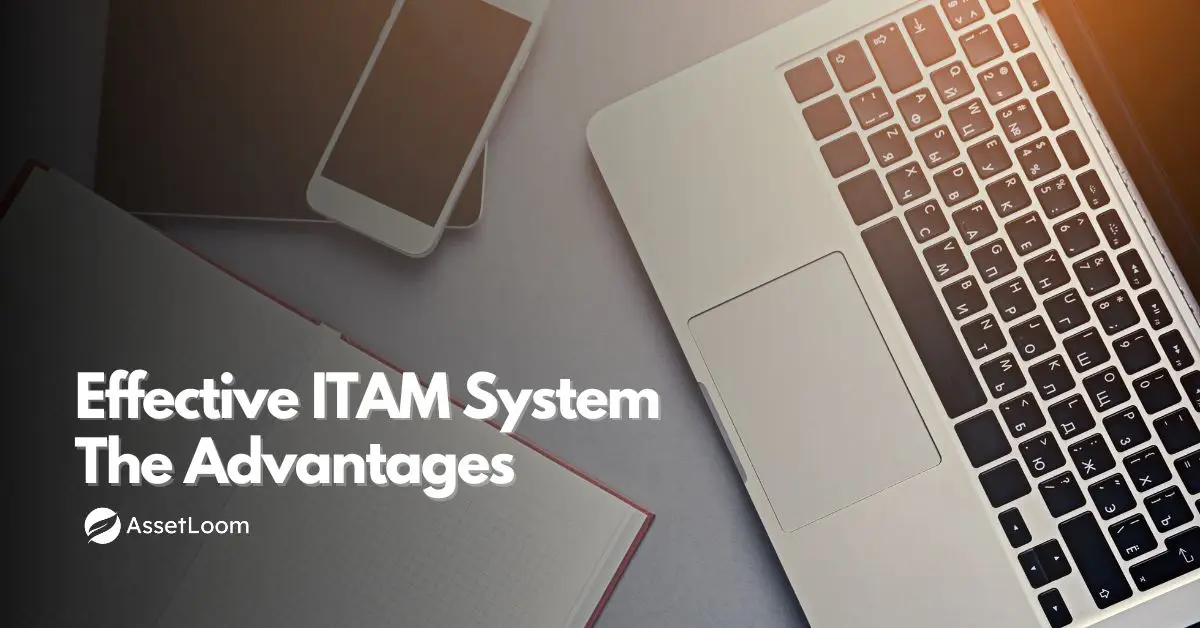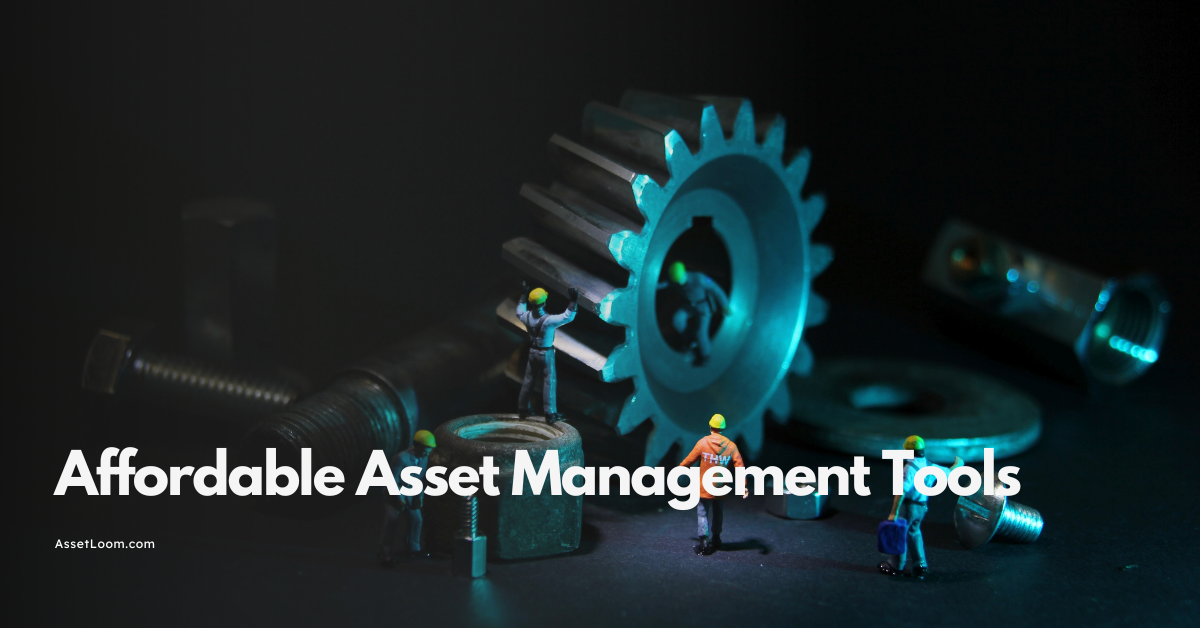10 Must-Know Tips to Choose the Best Monitoring Software for Your IT Needs
Discover 10 essential tips to help you select the best monitoring software, optimize performance, and ensure smooth IT operations across your infrastructure.
Choosing the right monitoring software can be a challenge for businesses. With so many options out there, it’s easy to run into issues like missed alerts, irrelevant notifications, or tools that don’t integrate well with existing systems.
In this blog, we’ll share 10 must-know tips to help businesses avoid these common headaches and choose the best monitoring software for their IT needs, leading to smoother operations, more effective alerts, and better overall performance.
Tip 1: Don’t Settle for the First Tool You Try
When it comes to monitoring software, it’s tempting to settle for the first option that looks good. But jumping in too quickly can lead to disappointment down the road, especially when it comes to asset monitoring.
What to Do: Take the time to test out multiple options. Many monitoring tools offer free trials or demos, use them! This allows you to get a feel for the software’s interface, features, and how well it integrates with your existing systems before making a commitment.
Why It Matters: Each business has unique needs, and what works for one might not work for another. By testing a few tools, businesses can ensure they choose one that fits their environment and provides the features that matter most.
Pro Tip: Make sure to involve your team in the testing process. They’ll be the ones using the software daily, so getting their input early on can save a lot of time and frustration later.
Tip 2: Prioritize Real-Time Monitoring and Alerts
When it comes to monitoring software, real-time data and alerts are absolutely essential. There’s no point in having a monitoring tool if it doesn’t alert you to issues as they happen.
What to Do: Look for software that provides instant alerts for key performance indicators (KPIs), such as server health, network uptime, and resource usage. These alerts should be customizable, so you can prioritize what's critical to your business and avoid unnecessary noise.
Why It Matters: Real-time monitoring ensures that businesses can address issues immediately, minimizing downtime and preventing performance issues from escalating. Waiting until the next report or manually checking systems can result in missed opportunities to solve problems before they impact your operations.
Pro Tip: Set up alert thresholds specific to your business. For example, if you rely on certain servers for key applications, configure alerts for resource usage or performance dips above a certain threshold to catch issues early.
Tip 3: Look for Customizable Dashboards and Reports
Not all monitoring software comes with dashboards that are easy to understand or aligned with your business's priorities. Customization is key to getting the most out of your monitoring tool.
What to Do: Choose software that lets you tailor dashboards to display the ITAM metrics that matter most to your business, whether that’s server uptime, network performance, or application health. Being able to quickly glance at a dashboard that highlights critical data makes decision-making faster and easier.
Why It Matters: A customizable dashboard helps your team focus on what’s important, eliminating the need to sift through irrelevant data. Plus, reports that are tailored to your needs provide more actionable insights, saving time when addressing issues.
Pro Tip: Make sure your dashboards are user-friendly. The goal is to make monitoring and troubleshooting easier, not more complicated. Customizing these views so that they're clean and intuitive can drastically improve your team’s productivity.
Tip 4: Ensure Cross-Platform Compatibility
If your business relies on a mix of on-premises infrastructure, cloud services, or hybrid setups, the last thing you want is a monitoring tool that only works in one environment. Your monitoring software should work seamlessly across all platforms.
What to Do: Look for software that offers cross-platform compatibility, whether you’re using AWS, Azure, Google Cloud, or on-premises servers. It should integrate smoothly across all these systems, giving you a unified view of your IT infrastructure.
Why It Matters: Businesses today often operate across multiple environments. If the monitoring software can’t handle both cloud-based and on-prem systems, it can create blind spots, making it harder to track performance, security, and uptime effectively.
Pro Tip: When evaluating tools, ask the vendor about integration capabilities with your current setup. A good monitoring tool should support not only your current systems but also future cloud platforms or new tech your business might adopt.
Tip 5: Choose Software with Smart Alerting Features
When evaluating monitoring software, one of the most important features to look for is how it handles alerts. The right software should help you manage alerts effectively, preventing notification overload while ensuring critical issues don’t slip through the cracks.
What to Do: Ensure the software you’re considering offers customizable alert thresholds so you can receive notifications based on your specific needs. Look for features like multi-tiered alerting (e.g., alert escalation) and snooze functionality to prevent overwhelming your team with low-priority notifications.
Why It Matters: Alert overload can lead to alert fatigue, where too many notifications cause users to miss important ones. Choosing software with intelligent alerting systems ensures you only get notified for high-priority issues, saving time and resources.
Pro Tip: Look for software that allows you to set different alert levels for different teams or departments. This way, critical issues are prioritized and escalated appropriately, while non-urgent alerts can be handled by lower-level staff.
Read also: How to Set Up Alerts for Asset Warranties and Renewals
Tip 6: Ensure Easy Integration with Existing Tools
When choosing monitoring software, it’s important to consider how well it integrates with your existing tools and infrastructure. The best monitoring solutions don’t work in isolation, they need to connect with the other systems you're already using to ensure seamless workflow and automation.
What to Do: Look for software that offers out-of-the-box integrations with your current platforms and tools. Whether it’s your ticketing system, cloud services, or network management tools, make sure the software can easily sync data between systems.
Why It Matters: Integration simplifies your IT operations and ensures that you don’t have to waste time manually transferring data or switching between different tools. The more integrated your monitoring software is, the more streamlined your operations will be.
Pro Tip: During the evaluation process, ask vendors about API access. This will help you customize integrations with any internal tools or third-party services you use, providing a more tailored monitoring solution.
Tip 7: Look for Scalability as Your Business Grows
As your business grows, your IT infrastructure will likely become more complex. The monitoring software you choose should be able to scale with you, handling increased traffic, additional systems, and expanded resources without compromising performance.
What to Do: Ensure that the software can easily handle increased load as your business expands. Look for tools that can scale across multiple environments, whether you’re adding more servers, cloud resources, or integrating new technologies.
Why It Matters: Software that can’t scale effectively will quickly become a bottleneck, leading to slow performance or missed issues. The best monitoring software grows with your business, ensuring that you won’t have to replace it as your infrastructure evolves.
Pro Tip: When evaluating scalability, check for auto-scaling features. This ensures the tool can handle spikes in traffic or demand without manual intervention, allowing your IT team to focus on more important tasks.
Tip 8: Don’t Overlook Security Monitoring Features
While performance monitoring is crucial, security monitoring is just as important. The best monitoring software should help detect security vulnerabilities, breaches, and unauthorized access across your systems in real time.
What to Do: Look for software that provides security-focused features such as vulnerability scanning, real-time threat detection, and compliance tracking. These features will help identify security issues early and mitigate potential risks before they cause damage.
Why It Matters: Security breaches can have devastating consequences, from data loss to reputational damage. By choosing software with strong security monitoring, businesses can protect their infrastructure and data from emerging threats.
Pro Tip: Make sure the software supports integration with your security tools (e.g., firewalls, antivirus software). This allows you to have a unified view of both performance and security, ensuring nothing slips through the cracks.
Tip 9: Assess the Software’s Cost vs. Features
While it’s tempting to choose the cheapest option, the best monitoring software is the one that delivers the most value for your business. It's important to evaluate the cost vs. features to ensure you’re getting the right balance.
What to Do: Compare the features offered by different tools and assess whether they align with your specific needs. Don’t be swayed by a low price if it means sacrificing critical features that would benefit your business in the long run.
Why It Matters: Opting for a cheaper tool might save money initially, but if it doesn’t have the features required to manage your infrastructure effectively, it can lead to higher costs down the road, whether through missed alerts, inefficiencies, or additional software you need to buy.
Pro Tip: Look for pricing transparency. Some software solutions have hidden fees (e.g., for extra users, data storage, or advanced features). Make sure you understand the full cost structure before making a decision.
Tip 10: Consider Vendor Support and Documentation
Great software is only useful if you have the support you need when issues arise. When choosing monitoring software, ensure the vendor provides reliable support and comprehensive documentation.
What to Do: Check the vendor’s reputation for customer service and make sure they offer 24/7 support. Additionally, look for detailed user guides, video tutorials, and a knowledge base that will help your team get up to speed quickly and troubleshoot issues as they arise.
Why It Matters: Good support ensures that you can resolve any issues quickly, preventing downtime or gaps in monitoring. Quality documentation and training resources will help your team maximize the software’s potential and use it efficiently.
Pro Tip: Take advantage of any free training or onboarding sessions that the vendor offers. This can help your team become familiar with the software’s capabilities and features from day one, speeding up implementation.

Conclusion
Choosing the right monitoring software is key to keeping your IT systems running smoothly. By following these 10 must-know tips, businesses can select a solution that meets their needs, optimizes performance, and ensures security.
Take your time, test multiple options, and involve your team to find the perfect fit. With the right tool, you’ll minimize downtime and boost efficiency.
Next Steps: Explore software options, try free trials, and apply these tips to make an informed decision.

Related Blogs
Subscribe for Expert Tips and Updates
Receive the latest news from AssetLoom, right in your inbox.

